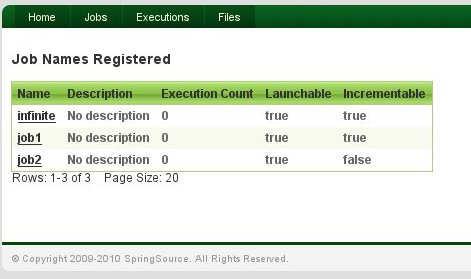Uploading Job Configurations to Spring Batch Admin
An interesting problem that has no universal good solution is: how do I change the configuration of a running Spring application? Spring Batch Admin 1.0.0.M3 was released recently, and it has a configuration upload feature that solves this problem in a particular way. Someone asked for this feature at the recent S2GForum in Munich (if you missed that sign up for events in London and Amsterdam in May), and I was happy to tell him that it already existed, so maybe it deserves a bit more air time...
Screenshots of the Basic Use Case
 We start with a look at the Jobs view in the application. It shows a list of jobs that are either launchable or monitorable by the web application.
We start with a look at the Jobs view in the application. It shows a list of jobs that are either launchable or monitorable by the web application.
Now the plan is to upload a new

